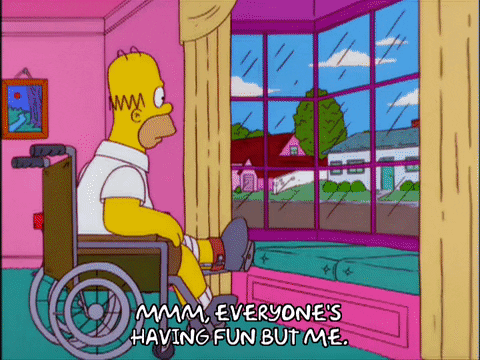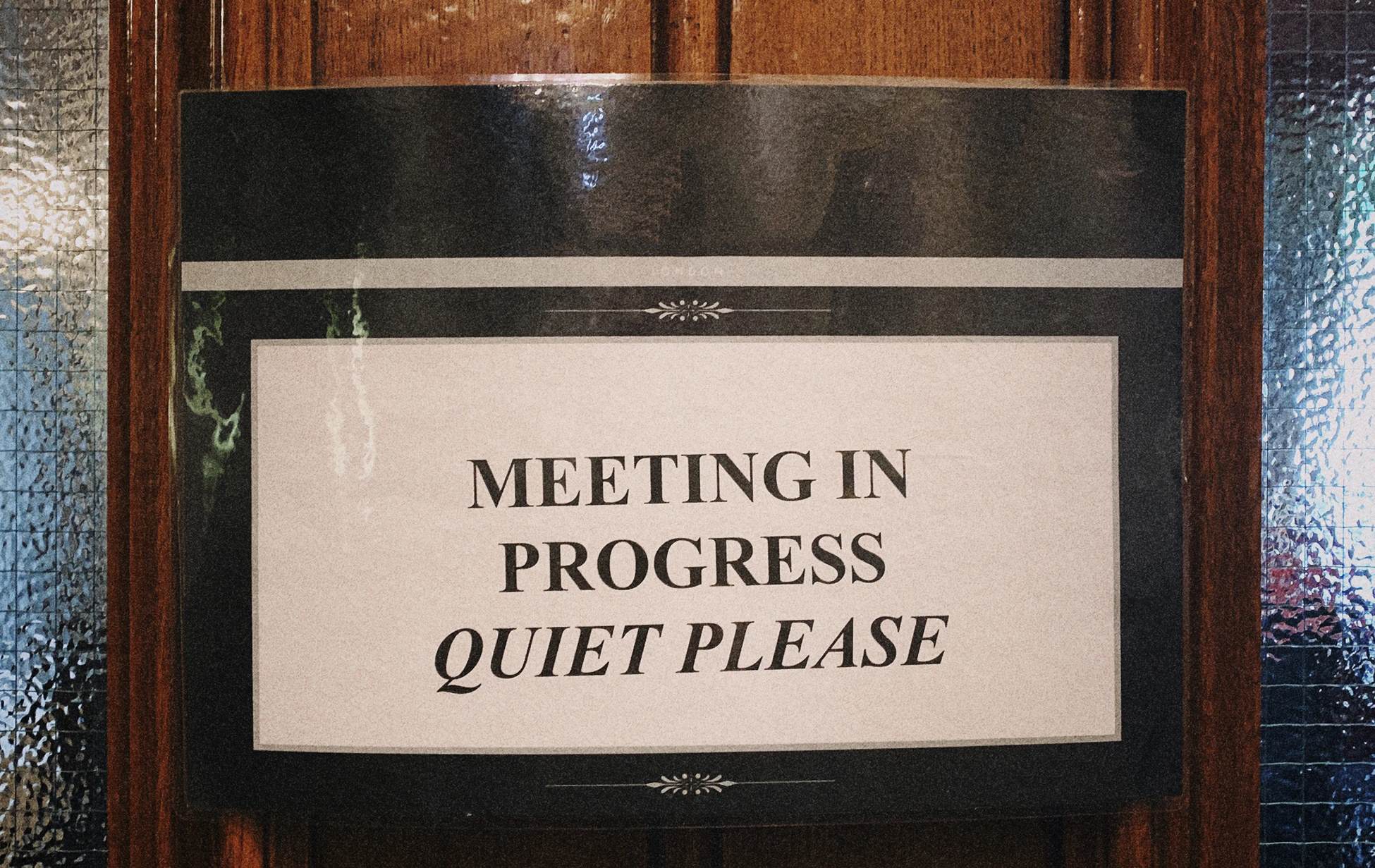A guide for minimizing FOMO at work and achieving more clarity around tasks, projects, and your position in the organization.
The grass is not always greener on the other side. I am sorry to have to disappoint anyone reading this, but it is true. This idea that things will be better or that having more information will lead to more satisfaction or understanding or something that will help you to fell happier and more fulfilled at the end of the day is not always accurate in the business world. I am speaking here of that feeling of anxiety that can creep in when seeing managers or upper level people go into a room, close the door and have a discussion. What are they talking about? How will it affect me? This type of event has always bugged me and is one of the underlying reasons that I moved into management. I wanted to be in the room where it happens.

This idea of missing out is not a new one. There is actually terminology for this effect that was added to the Oxford English Dictionary in 2013. FOMO, or Fear Of Missing Out, is a recognized state of heightened anxiety where one feels that other people are more in-the-know than you are and this is causing you to miss some of the things that could provide more happiness or benefit to you. A 2013 study on this topic, “Motivational, emotional, and behavioral correlates of fear of missing out” states the following definition for FOMO:
…the uneasy and sometimes all-consuming feeling that you’re missing out – that your peers are doing, in the know about, or in possession of more or something better than you.
This fear manifests itself in many ways. Much of the research that was done for this post shows myriad articles referencing social media FOMO as a hot topic. The attention paid to this type of anxiety has certainly received a lot of attention over the past 5 years. There are even articles talking about JOMO as the new FOMO with the meaning referencing the Joy of Missing Out as a way to take a break and prevent the burnout that is associated with the condition. If we as a society have gotten to the point where there is already a counter-culture around FOMO then it must be pervasive and wide-spread indeed.

My own experiences included quite a bit of workplace FOMO. I was hired for my first major Engineering role at a company in the midst of a bankruptcy. Reductions In Force (RIFs) were a fairly common occurrence. The gossip and rumor mill was in full swing as I have discussed in a piece called Secret Weapons: Candy Edition. I happened to also be talented enough to get feedback calling out my contributions and talent but was not yet wise enough to understand the time and experienced needed to be moved into a senior position. This lack of immediate movement and continual organizational change helped to create my youthful fears that I was missing out. These factors contributed to the impatience and anxiety that eventually led to me pursuing other opportunities. These have also set the stage for me in subsequent stages of my career to be able to recognize similar anxieties in the Engineers that I work with and have allowed me to take steps to try and avoid similar changes in circumstance for people ton my team.
Yet, even as a manager, while I can be proactive about creating an anti-FOMO environment, every Engineer needs to take steps to not let this anxiety get out of control. This fear served as the impetus for this post and inspiration came from my 478th playback of the original Broadway cast recording of Hamilton. One of the songs on this soundtrack is titled: “The Room Where It Happens” and highlights some working Fear Of Missing Out:
No one else was in
Lin-Manuel Miranda, Leslie Odom Jr., Daveed Diggs, Okieriete Onaodowan, Original Broadway Cast of Hamilton, 2015. Songwriters: Lin-Manuel Miranda. The Room Where It Happens lyrics © Warner Chappell Music, Inc
The room where it happened
The room where it happened
The room where it happened
No one really knows how the game is played
The art of the trade
How the sausage gets made
We just assume that it happens
But no one else is in
The room where it happens
So what exactly is workplace FOMO and how can you tell if you have it? Classic descriptions usually focus on social media. Often they are framed with questions like: ‘Have you ever sat at home, alone, drinking a glass of wine and constantly refreshing your [insert social media app here] page with a fear that everyone you know is out having fun while you definitely are not?’ Or ‘Do you get overly stressed or anxious when you don’t understand an inside joke that others in your friend circle immediately understand? ‘ Answering yes to either of these indicators might prompt a possible diagnosis of FOMO. But the workplace is different. Most agile teams are 3-5 people. Many departments are a handful to maybe a couple of dozen people. Surely there can’t be enough chatter and noise and slack posts to drive that much apprehension. Right?
The elements of workplace anxiousness should be defined in a slightly different manner. The first piece of the puzzle is defining where the noise is coming from at work. This can be from various sources, and not all of them are defined below, but all of these contribute noise that can impact and create unease for a person:
- Instant Messaging – Whether using Slack or Microsoft Teams, Flock, HipChat, ChatWork, or any other type of messenger, a lot of noise can come from these tools. Manually generated messages aside, the amount of overall noise really ramps up when automation comes into play. Have you ever observed the notification chatter from Github from an active development team? Pull requests along can generate dozens of messages a day. What about a channel for notifications from a build server that is configured for builds based off of approved pull requests? Overall, these apps can constitute a flood of information coming at someone and make it hard to keep up with what is going on
- Email – The original electronic scourge of decreased productivity, there is a reason that some companies implement email policies that prevent emailing during certain times of the day. ” Suppose each time you ran low on an item in your kitchen—olive oil, bananas, napkins—your instinctive response was to drop everything and race to the store. How much time would you lose?” (from an article: The Cost of Continuously Checking Email)
- Meetings That You Aren’t Invited To – What could they possibly be talking about behind that closed door? Not being invited to meetings when you have the perception that important decisions are being made in that room can be a total downer when it affects how you feel you are perceived in the hierarchy of the workplace. If I am not in that room contributing then surely they don’t value me very much…
- Meetings or Conversations That You Are Invited To – Now you are part of the conversation, but what if instead of being a leader and contributor you are just sitting there listening to all of the amazing things being accomplished by other people on the team? Instead of being productive gatherings, meetings can add quite a bit of apprehension to anyone’s day even if you aren’t being asked to get up in front of a bunch of people and present
- Personal Stuff – Let’s not forget, the world doesn’t stop turning while we are at work. The internet doesn’t shut down for 8-9 hours a day and like it or not, there are always people out there with a day off, working from home, or that just live in their parent’s basement who are posting stuff every minute of every day. Personal issues certainly play a part in people’s moods and emotions while at work and can contribute additional angst on top of any that is coming from the workplace
Ack! It is too much! I feel overloaded just writing this piece. Why do we do this to ourselves and maintain any semblance of sanity throughout the business day? What solutions can be found to not only get through every day of the work week but to also come out ahead in terms of actually getting something done? What are some ways to manage the stress that comes from our workplace without getting frustrated, experiencing burnout, or worse?
Stop… Breathe.

The immediate thing to do is to step back and breathe for a moment. This is the first and one of the most important skills that anyone can have towards overcoming this stress. The first thing to do is to realize that no matter what, the sun will come up tomorrow, the earth will keep spinning, and there will always be more work to do. The goal here is to attempt to change your perspective and help put things into context. This is not just a good skill for stress, but is a great skill to foster for everything you do at work. Taking a moment to step back and breathe stops your initial nasty gut-reaction email from going out and gives you a chance to rework the words into a more positive and constructive message. Taking a moment to step back helps to drain the stress, anger, resentment, or frustration away and let’s everyone focus on the solution for the problem instead of getting upset that a problem exists in the first place. Remember:
Work is infinite, but time is finite.
Melody Wilding, LMSW from the article Work Is Infinite, But Time is Finite
With some perspective on the thing or things that are causing the immediate stress, now the focus can turn towards other ways to manage workplace stress and reduce workplace FOMO. Since the work will never end, we have to find ways to manage it and to navigate the pitfalls of the workplace. The following are a list of suggestions that you can use to build in some buffers, focus more on getting work done, and less on feeling left out or stressed due to information overload. To start, let’s take another look at Hamilton.
The entire purpose of the song “The Room Where It Happens” is to attempt to provide some context to a gap in the narrative that formed the basis for the musical. Lin Manuel Miranda drew the source material for the musical from historian Ron Chernow’s biography, Alexander Hamilton. The event in question is a dinner meeting between Alexander Hamilton, Thomas Jefferson, and James Madison. Aaron Burr provides the imaginary narrative for the dinner party in a masterful example of political FOMO (as he was not present) while explaining that the end result of the meeting resulted in the location of the nation’s capital (on the Potomic River now known as Washington D.C.) as well as enacting a federal taxation plan that Hamilton was proposing. Or through much more eloquent verse:
The art of the compromise
Lin-Manuel Miranda, Leslie Odom Jr., Daveed Diggs, Okieriete Onaodowan, Original Broadway Cast of Hamilton, 2015. Songwriters: Lin-Manuel Miranda. The Room Where It Happens lyrics © Warner Chappell Music, Inc
Hold your nose and close your eyes
We want our leaders to save the day
But we don’t get a say in what they trade away
We dream of a brand new start
But we dream in the dark for the most part
Dark as a tomb where it happens
I’ve got to be in
The room where it happens
In a way, these lyrics are a blueprint for addressing the sources and causes of the affliction known as workplace Fear Of Missing Out. Taking a look at sets of lines from the verse shows us ways to go tackle this fear and find different ways to overcome these effects while at work.
“The art of the compromise – Hold your nose and close your eyes”
This one is straightforward. Reduce your noise and limit your sensory inputs. Shut it out, hold your nose, close your eyes. Put in some earplugs if you need to. By compromising on the things that you have in front of you and focusing only on the elements that provide you with truly meaningful information you will have more bandwidth to appropriately consume the information flow that is reaching you instead of the ‘drink from a fire hose’ approach that is all to common these days.
- Reduce The Number of Tools You Use – The more tools that are used the more context switching that must occur in order to complete tasks. For most Engineers, completing tasks provides a shot of dopamine in the same manner that dopamine can influence someone compulsively checking Instagram. The good news is that you don’t get paid for checking Instagram, you get paid for completing work tasks. A reduction in the number of communication channels and tools allows more focus on what needs to be worked on instead of getting distracted by things that aren’t that important, makes you better at your job, and allows you to build your habits around the simple and straightforward work tasks and not the distracting Outlook new email notification
- Adjust Your Notification Settings – For the tools that you do end up using, take the time to investigate the settings for that tool. Pretty much every communication tool and project management app has some sort of notifications settings. Outlook certainly does. Even Windows 10 has new Focus Assist settings. If you are still having trouble staying focused there are even blockers like StayFocused, a chrome extension that stops access for sites during certain time periods. Modifying notification settings allows only the most important messaging through and helps to greatly lower the noise coming at you every day.
- Understand That Multitasking Is A Myth – Whether or not you believe this statement, focusing on single-tasking can provide a lot of benefits in your daily work. This allows all of your attention to be put against the singular task that you are working on and if nothing else, limits your access to the other noise and communication channels that may be causing anxiety by checking them so often. You can also treat your checking of email and other channels like a task and check another item off your list by setting up dedicated time to focus just on that for a certain part of your day.
- Define Your Own Processes And Stick To Them – One way to exert control over your steps and actions throughout the work day is to establish your own routines and processes. Things like how you take notes, where and how you keep a todo list, and task management. By building your own processes you not only are able to establish the most comfortable methods for how you do things but you also retain authority over your actions throughout the day. Owning the management of your time is a great way to build confidence in your actions and avoid FOMO.
“We want our leaders to save the day – But we don’t get a say in what they trade away“
This one should be looked at in reverse order. The feeling of missing out can be strongest when we feel that we don’t have a voice or a part of the decision making process. This is exacerbated when the decisions and reasons behind those decisions are not transparent to all involved. The answer to not having a voice is to step up and be more of a leader and work from your position to build the connections needed to start gaining some visibility into different areas. In doing so this will lift some of the veil and show the information that has been hidden. The goal here would be to work at becoming more of a leader so that you do have a voice in the decisions being made and therefore have more visibility into, and connection with, daily business functions.
- Choose Your Battles – This item is all about controlling what you can and exerting influence over your environment. However, in doing so, don’t try and control everything. You won’t be able to which can lead to more stress. When choosing which areas to control make sure that you are assigning appropriate levels of importance to different events. What is more important, getting into an argument over who should clean the coffee pots or getting everyone on board with an amazing idea for the next project? The philosophy of not sweating the small stuff is a great leadership trait. Following this advice over time allows others to realize that when you choose to fight for something that it has meaning and is worth careful consideration and review.
- Stay In The Know – If meetings are optional then don’t be afraid to go see what is going on. Use the tools available to you to check out product roadmaps and upcoming initiatives. Use this information to position yourself in a good place to be involved and knowledgeable about these projects. In doing so you will create transparency that shows that you aren’t missing out and if used right, can provide opportunities to step up and tackle new projects and show leadership in different areas.
- Build Face To Face Relationships – You can build relationships via text and communication tools, but a huge part of human communication is non-verbal. There is even less understanding provided when communicating only by text. The chance for words to be misinterpreted when chatting on Slack is much, much higher than when talking to someone face to face. Taking time to build your relationships in person will go a long ways towards making communication better and then, when communication does need to occur via text, the chance of the message creating anxiety from being misread is much less.
- Ask for 1-on-1s – These face-to-face meetings are becoming very popular for the interaction and relationship building opportunities that they present. Not only do they provide a two way street for feedback and constructive criticism, but they present huge opportunities to address many of the symptoms of FOMO through straightforward conversations. 1-on-1 meetings with your manager can be a great way to gain insight and knowledge, build relationships, and work through workplace anxiety.
“We dream of a brand new start – But we dream in the dark for the most part – Dark as a tomb where it happens“
We are back to the first step – breathe. Relax. Understand that stress can feed on itself and grow to overwhelm even the strongest of people. There are many times that the Fear Of Missing Out can lead to the Dark Side where fear, anxiety, and anger rule. These feelings can eventually lead people to look for other opportunities for a new start where these feelings might be lessened or avoided. However, the root cause behind these feelings won’t go away through a change of venue. Before changing your life and jumping at a new opportunity to try and change first, you may first want to focus on the here and now and explore how to get into a better state of mind in the here-and-now. If you do this and still feel the need to test the waters elsewhere then at least you doing so with a clear hear. So now instead of fantasizing about missed opportunities and greener pastures in a dark tomb-like office where it is just you and your headphones chugging out code like there is no tomorrow – focus on bringing some light and interaction into your routine at work and see if that can help quell some of the anxiety before it starts.
- Be Realistic – No one person can be a part of every project and help out on every task, nor can any one person consume every message that is generated in a day from any organization. You will have to let some things slide, and that is OK. Remember, there are people out there embracing JOMO – the Joy Of Missing Out. It can be a powerful tool. It is OK to go full Elsa sometimes and just “Let It Go“
- Engage Teammates And Help Others – Interacting with other people on your team or even other teams and groups in the organization is a fantastic way to not only build relationships but to also see what others are working on, stay in the loop, and to build leadership skills that can open more doors going forward. Even if you aren’t jumping in on a work problem, maybe you are getting out of your office and sitting with others at lunch or going on a walk around the block with some teammates. Engagement builds communication.
- Shift Your Focus – Let’s face it, FOMO is a mental condition. If you can figure out how to identify when you get into that state then there is a good chance that you can take steps to change your mental state into a more positive and productive mindset. This isn’t easy, but in building your own processes and focusing on singular tasks it is possible to re-focus on one thing and work to move on if and when you start feeling like you are missing out on something.
- Practice Mindfulness – If all else fails maybe some general focus on yourself can get you over the hump and into a better state of mind. Exercise is great. Maybe try finding a 2-5 minute meditation routine and trying that in a quiet corner when you feel anxiety stating to build. Going outside for a few minutes during a break or at lunchtime to soak up some vitamin D might improve your outlook. The goal here is to focus on yourself and your needs so that you can get past this anxiety and be the best you that you can be. In doing so you will also get the benefit of being the best teammate and Engineer that you can be as well.
“I’ve got to be in – The room where it happens“
Hopefully at this point you realize that you don’t have to be in the room where it happens to feel fulfilled and happy at work. Additionally, if this is a goal from a career growth standpoint there are feasibly some pointers here that can help you get on the path towards achieving these goals. If nothing else, maybe this information will help someone, somewhere identify their own FOMO and find a few ways to combat those feelings and gain a more positive outlook on work and life.
This will not be easy. The conditions that bring about FOMO are not going away – they will almost certainly get worse. Information overload only going to get worse as more systems and data come online in the future. There are bright spots. AI functionality may help to consolidate and streamline notifications. We as a society may learn to unplug more and work a little less as automation gains traction.

These are things for the future. For the here and now, instead of staying on the negative FOMO spiral focus on the positive and happy path. Targeting and thinking about happiness begets more happiness. Fixating on cheerful things allows for the expression of gratitude and helps to reinforce joy. Maybe you can even define your own room and then you don’t need to stress and waste time lamenting that your aren’t in someone else’s room where it happens because you don’t need that anymore – you are already there. Thanks for reading!


Comments are closed, but trackbacks and pingbacks are open.